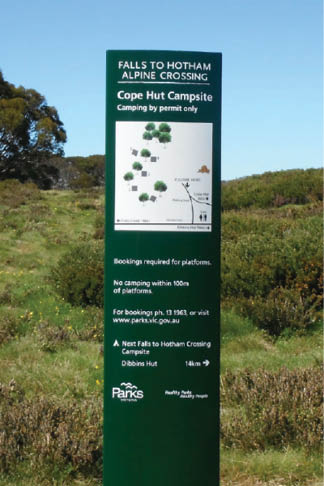{{{description}}}



Falls Creek to Hotham Alpine Crossing
Stephen Lake

The Victorian Government has a policy of establishing four “icon walks”. The first is under construction, in the Grampians. When completed it will go from Mt Zero to Dunkeld, 144 kilometres. The Great Ocean Walk is another, from Apollo Bay to the 12 Apostles, 100 kilometres. The third is Falls Creek to Mt Hotham, 40 kilometres. The concept is nice but it does not always work. The following article discusses the Falls-Hotham walk and is based on the Preliminary concept master plan (“Preliminary Plan”). At present the Draft master plan will be available in September-October 2016.
Northern RazorbackRyan Judd
66 | BWA April 2016

Initial informationThe Falls to Hotham Crossing is in the planning stages and it's something of a muddle. There's already a walk by the same name camping at Dibbins Hut and two nights. Using the same name has caused confusion in the bushwalking community, with significant differences in the two routes that are not clear enough.
There are two main public documents about this proposed walk, the website summary and the Preliminary Plan cited above. The Preliminary Plan shows a new track cutting Diamantina Spur a short way above the current start at the road, three nights and 40 kilometres. The Parks Victoria (PV) website says to go via Dibbins: “A permit is required to camp at the Falls to Hotham Alpine Crossing campsites.” This is misleading. While you need a permit to camp at the camping platforms, you are still allowed to camp in most parts of the park without a permit, but not within 100 metres of these camping platforms.
Economic viabilityThe Preliminary Plan says: "The Falls to Hotham Crossing will provide demonstrable economic benefits”. I assume this means they expect a reasonable return on the investment. I think this is presumptuous and should not be included. There has been no PV economic or cost-benefit analysis, so it's impossible to state exactly how much the walk will cost to set up and maintain. The main costs are infrastructure, maintenance and staff. It beggars belief that a preliminary cost-benefit analysis was not undertaken before the release of the discussion information.
I asked PV about this and was advised “The first step in determining an accurate economic analysis is the development of a broad concept (in this case, a proposed route) and test that idea with community and stakeholders.” This does not make sense to me. It's very easy to do a cost-benefit analysis based on proposed options. I did this, took less than an hour. Why not do this before spending much time, effort and cost with the consultation process? One hour would have shown that the economics do not support the proposal.
My low figures are about $1.28 million to build, $200,000 a year to maintain and will attract perhaps 1100 paying visitors a year, a very high number. PV says that there will be no fees for other walkers. To see a return on their investment within 10 years this means that PV needs to collect $300 per guided walker, camping on the platforms. When the costs of the commercial entity are added the total will be closer to $2700.
I cannot see independent walkers paying $300 or so to camp on platforms when they have happily camped on grass for ages with no fee. When you compare this to the expensive new Tasmanian Three Capes Walk – up to $500 per person staying in high-class huts - you can see that this walk will cost a similar amount for camping. Many families and walkers will find this price prohibitive. Note that I cannot be sure of the fees as PV has not advised about them.
For just four days this is a lot, especially as the first day is quite short. Compared to the Overland Track this is hugely expensive.
Cope Hut campsite sign

BWA April 2016 | 67
The Overland Track guided walk of four days is $2350. The cost of a current guided commercial walk Falls Creek-Hotham-Feathertop-Harrietville starts at $2400, with just four walks programmed between December 2015 and February 2017, maybe 40 clients. This is on the main pole line, easier than the PV proposal and includes Feathertop, yet they have very few clients. These figures support my view that the proposed walk is too hard and will not attract many people.
Any economic benefits will be tiny compared to the ski season, where more is spent at resorts in one day than will be spent by walk patrons in a year. In response to this point PV said “The specific economic benefits of any project cannot be determined until the planning and assessment stages have been undertaken.” Not so – I've done it. The government has cut back PV funding (vnpa.org.au) and is unlikely to fund works or maintenance, which means that there could well be environmental degradation. Not good.
PV say that the economic analysis comes after the broad concept plan. This Preliminary Plan exists and it's possible to do an analysis. This analysis has been done and the broad concept plan does not work, too expensive, dreadful cost-benefit.
In mid-2015 PV said that the Walk Plan “will provide demonstrable economic benefits”. PV now says “The establishment of an iconic walk in the Australian Alps has the potential to bring economic benefits, as well as social, employment and environmental benefits, to the north-east and the resorts in summer.” Note the word “potential” - no guarantee. So in about nine months the benefits have gone from certain to potential. The process is being done backwards. PV should have made a proposal, done a preliminary in-house analysis and if the idea looked good, then undertaken detailed planning and
consultation. The economic benefits will be tiny compared to winter. Why bother? Is anybody listening? Apparently not.
PV says that “a thorough economic assessment and modelling of the environmental, social and economic benefits of this walk proposal will be undertaken as part of the next phase of design. It is not possible to accurately cost works and model benefits without a more developed design. The preliminary concept does not provide a sufficient level of detail to undertake this.” Accurate figures are not required - preliminary figures will suffice. PV has had information for three months, time enough to get a rough idea.
So when the Preliminary Plan says “The Falls to Hotham Crossing will provide demonstrable economic benefits”, or the latest PV view about the “potential to bring economic benefits”, I wonder about the significance of these benefits.
Environmental impactThe Preliminary Plan has a standing camp or hut at or near The Razorback at High Knob. The Preliminary Plan suggests there may be one or two campsites in two main areas, part of the way up Diamantina Spur or at Federation Hut. There's usually a lot people camping at the Federation Hut area - no more room there! The way the plan is drawn suggests that High Knob on the Razorback is also a possible site, although less likely.
High Knob is in a Conservation zone, defined as "Areas of high natural value where the emphasis is on protection of the environment." PV says “The preliminary concept tests the idea of an overnight camp and/or hut on the top of Diamantina Spur below High Knob. It is a beautiful location that is already used by campers. This is not inconsistent with the zoning in the Alpine National Park Management Plan.” In my view the word “test” is spin. The

Feathertop Vicki Rickard
BWA April 2016 | 69
treatments to minimise erosion and the like. An upgraded Diamantina Spur is not needed to walk to Feathertop, a key fact that PV missed in the above. Dumbing down places will detract.
I asked about going via Machinery and Swindlers Spurs: safer and less cost. PV said “while the pole line may be acceptable for independent walkers, this route and the facilities do not meet the "world-class" standard that the current (walk) is aspiring to and which will allow it to compete with other iconic walks in Tasmania, New Zealand and overseas. PV considers that including Mt Feathertop as part of the walking experience is crucial in meeting this benchmark.” It's advantageous to compete on what we have that's better and different, not attempt to best other places. No amount of spin will vary the difficulty of Diamantina Spur. Why not go from Hotham to Feathertop?
PV says “Hotham to Feathertop will be any option as it currently is. But for those who are fit and capable and seeking a challenge, the iconic route which takes in Diamantina Spur will be an outstanding walking experience.” It already is an outstanding walking experience. More camping platforms mean that traditional places will be unavailable to those not using the platforms, and those of us who are used to walking this area will need to pay or find other areas to camp.
Summary and alternativesThe ANP Draft Plan and the proposed walk have insurmountable conflicts, although this makes sense because the first is a draft and the second is just a preliminary concept that once completed will advise the first. After all, that is why we have drafts. In my view, walkers will be placed at risk if PV make the changes proposed in the Preliminary Plan. The Walk Preliminary Concept Plan is economically, environmentally and aesthetically irresponsible, at odds with the historical use, and may not meet the zone requirements. Current users will be unable to camp where they have camped for many years, although to be fair I must say there is already a permit system required for two specific camping areas, but there may be three new campsites built. PV says “These are unsubstantiated, subjective claims.” I gave PV examples that substantiated my
advice, and PV did not reply. PV has not denied the above, and responses are still vague.
An easy solution that does not require much cost is to use the existing pole line or Machinery Spur. No new facilities are needed beyond maintenance on some steeper and wetter sections of the track. Why not put the walk here and assess the commercial viability? See if demand exists for a much harder walk up Diamantina Spur before spending $1-2 million. Another option is to overnight at Mt Hotham and make the last day a bit harder: Razorback, Feathertop and Harrietville. This will show visitors what it's like on a high ridge and major bushwalking peak without the need for an abhorrent hut on High Knob, which we know from the preliminary concept may be unlikely. If tiredness or weather so dictate then walkers can go for a day walk and then be driven to Harrietville to meet those that walked to Feathertop and then down.
Another option is for a real alpine crossing – Mountain Creek to Harrietville. This will take in Victoria's two highest mountains over a week or so. While being slightly short to be described as long-distance, it's acceptable. It also has the advantage of a low cost to set up. The numbers on this harder walk will not be as high as on an easier walk, but the cost-benefit is greater.
PV should be emphasising the unique features of Victoria, not attempting to compete with other places. It's quite probable that if we attempt to so compete we will lose. Loss of reputation will take years to repair.
The region is well worth visiting and has much appeal. The idea of promoting it and bushwalking in general is good. More work needs to be done to identify a viable solution. My strong view is that the above criticisms do not reflect the dedicated and competent PV staff. If PV had more resources their job would be a lot easier. Funding cuts are taking their toll.
See a discussion at bushwalk.com.
Parks Victoria were asked to comment about this article, and were kind enough to respond.
BWA April 2016 | 71